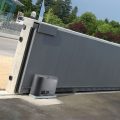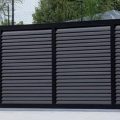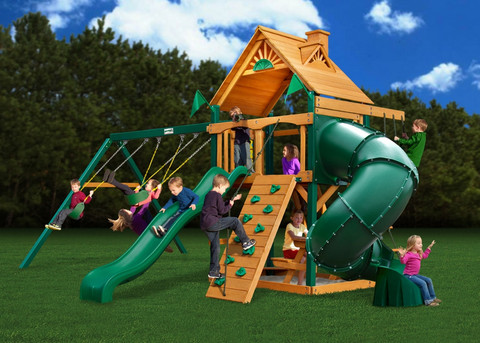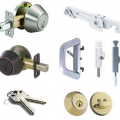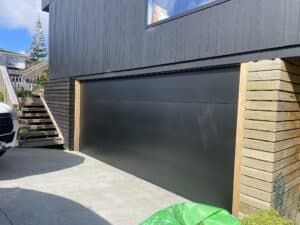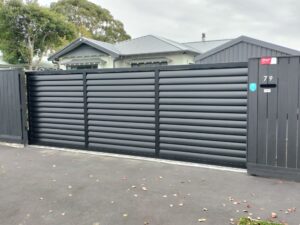When security for your home or business is an issue, should you get a Sliding Gate or a Swing gate?
ARC have been installing automatic security gates in Hamilton for years. Here are their suggestions for choosing which gate is right for you.
Swinging Automatic Gates
A swing gate is where two gates close to meet in the middle. Both side open when they receive an authentic signal from a remote control (for example).
A double swing gate with gates opening inside the property
These gates usually open inwards towards the home, although an uphill driveway means they might open outwards instead, providing the gates remain inside your property boundary.
How does a swinging automatic gate work?
Access through the gate is by way of a remote control.
The remote control sends a signal to the electronic control panel, which in turn, commands the actuators to pull the gates open, or push them closed. The column-mounted photocells are on the inside of the gate and allow for automatic opening when someone wants to exit the property. There is no need to use the remote control to exit the property in this case.
For people who do not have a remote, you can install an Intercom on your gate that can either ring inside your house or call you on your mobile phone. You can then talk to them and open the gate remotely to let them in.
However, there will also be people who you do know that need access. So, rather than giving them a remote control you can install an access control device such as a Digital Keypad and give visitors a pin number, which is also handy for the meter reader, gardeners, cleaners and kids coming home from school.
Sliding Automatic Security Gates
A sliding gate opens by sliding along the property fence line. A residential sliding gate is usually a single gate which, when open, may be hidden behind the fence or wall.

A sliding gate opens along the fence line.
How does a sliding automatic gate work?
Access through the gate is again, by way of a remote control. However, an underground magnetic detector can also be used. So that if any vehicle (as these would be comprised mostly of metal) drives up to the gate from inside the property it will open automatically for them.
Many sliding gates have wheels on the bottom, although some do not. There must be sufficient room to the left or the right of the gate for the entire gate to move out of the way, and for the motor to be off the driveway.
An option with most gate motors (operators) is to have it close automatically after a time delay but you see that there is a safety photocell by the gate, to prevent the gate from closing on a vehicle. The photocell can also be used to close the gate as soon as a vehicle has driven through for improved security.
So How Do I Choose a Security Gate?
There are three key considerations when it comes to choosing which gate is right for you?
Cost
Thanks to their more straightforward construction, swing gates generally cost less than sliding gates, though this largely depends on the size, style, and material of the gate in question.
Even though both gate types can be the same shape and size, sliding gates require a more complex opening mechanism and extra parts installed. For example, a swing gate consists of the motor and a couple of hinges mounted to a post or wall, while a sliding gate needs a motor, slide track, and rollers.
Space
Space is a factor in two directions. If there is limited space along the fenceline you may not have room for a sliding gate. So in this situation a swing gate will be necessary.
However, you may have limited space inside the property as well. A swing gate must be able to open fully following the driveway. This factor is frequently the reason people opt for a sliding gate instead.
Bear in mind that a single swing gate takes up more room than a double swing gate.
A single swing gate requires more room within the property than a double
A 4 metre single swing gate needs 4 metres of space behind the gate to swing freely whereas a 4 metre double gate would need only 2 metres.
Contour
If you have an uphill driveway, a swing gate would need to open outwards towards the road (and the waiting car) provided the gate stays within your property boundary. If space is an issue, or if damage to a vehicle coming too close is a factor, consider a sliding gate.
If the driveway is on an angle, or immediately makes a turn after entry, a wider double gate will handle this better than a single. This could be a double sliding or a double swing gate depending on other factors mentioned above.
BONUS TIP: Maintenance
If you don’t want to worry about gate maintenance, then a swing gate is probably the best option. It has very low maintenance compared to a sliding gate, which needs tracks to be constantly cleared, with even the smallest debris causing jamming issues along the track.
Long term maintenance is generally easier on a swing gate too. There are fewer parts in the opening mechanism as it is more basic than those used on sliding gates, meaning less chance of parts breaking down and needed repaired or replaced.

